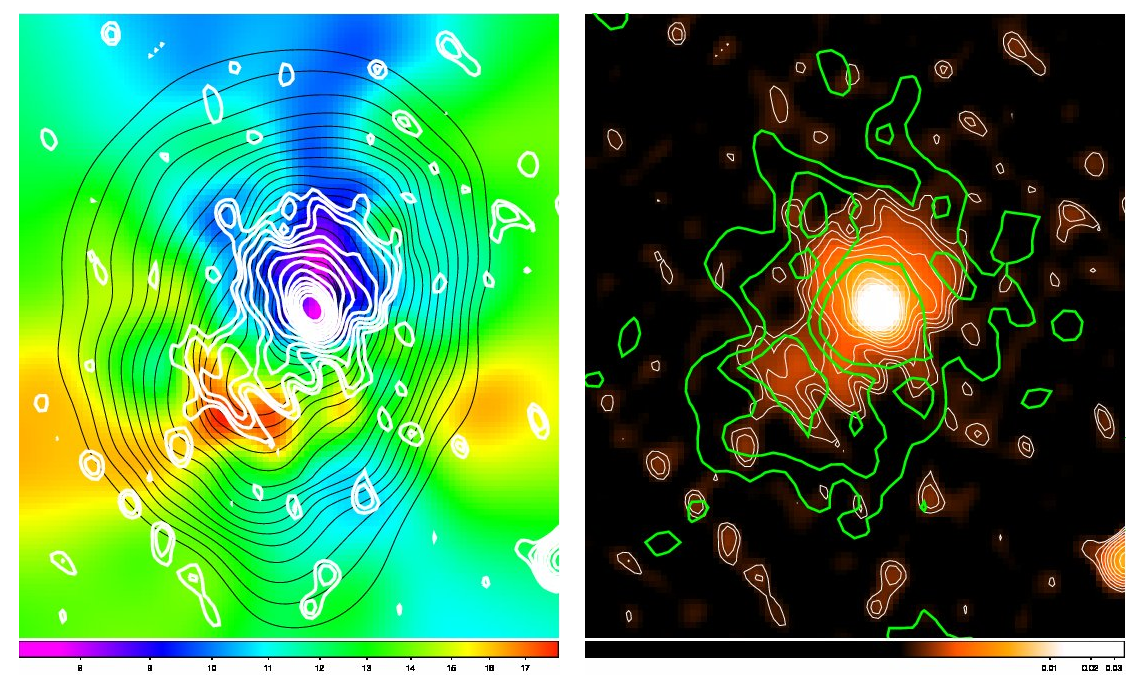Daily Image
24-08-2011Radio Emission from a Shock Heated Region Detected through SZE
| Submitter: | Michael Wise |
| Description: | The existence of a non-thermal component (GeV electrons and μG magnetic fields) of the intra-cluster medium (ICM) has been revealed by the detection of diffuse radio sources that are associated not with active galaxies but with the ICM itself. Through non-thermal studies of galaxy clusters we can estimate the cosmic-ray and magnetic field energy budget and pressure contribution to the ICM, as well as get clues about the cluster dynamical state and energy redistribution during merger events. Up to now, only about 10% of known clusters are “radio-loud” and show evidence of a diffuse non-thermal component in the radio band. Based on their physical properties, diffuse cluster radio sources are usually divided in three categories: halos, relics and mini-halos. Radio halos are low surface brightness sources, with a regular morphology, that permeate the central cluster region and extend out to radii of 1 Mpc or so. Relics have generally been found at the periphery of clusters and exhibit a wider range of morphologies. Mini-halos have sizes smaller than 500 kpc, and have been detected in the central regions of cool-core galaxy clusters, generally surrounding a powerful radio galaxy. The cluster RXJ1347.5-1145 is one of the most X-ray luminous and massive galaxy clusters known and has been extensively studied in the X-ray. It has also been the subject of a number of studies to measure the Sunyaev-Zeldovitch effect (SZE). These studies have identified a region of enhanced surface brightness and high temperature widely interpreted as evidence for an ongoing major merger. Using new 237 MHz and 614 MHz GMRT data, we point out for the first time in an unambiguous way the correspondence between a radio excess in a diffuse ICM radio source and a hot region detected through both the SZE and X-ray observations. Our radio results are compared with the MUSTANG 90 GHz SZE map and with re-processed Chandra and XMM-Newton archival data of this cluster. Our result indicates that electron re-acceleration in the radio mini-halo at the center of the merging cluster RXJ1347.5-1145 is most likely related to a combination of MHD turbulence within the cold core region and shocked gas between merging sub-clusters. With its improved sensitivity and spatial resolution, LOFAR will detect many such systems and provide an important complement to future improved SZE surveys. Figure Caption: (Left): XMM-Newton X-ray temperature map of RXJ1347-1145 in keV. X-ray iso-contours from the Chandra [0.5, 2.5] keV band image are superimposed in black. Total intensity radio contours at 614 MHz are shown in white. (Right): total intensity 614 MHz map and contours (white) of RXJ1347. Contours of the MUSTANG SZE image of the cluster are overlaid in green. The two panels have exactly the same physical scale. (For more details see Ferrari et al. 2011, http://arxiv.org/abs/1107.5945) |
| Copyright: | Chiara Ferrari |
| Tweet |  |
